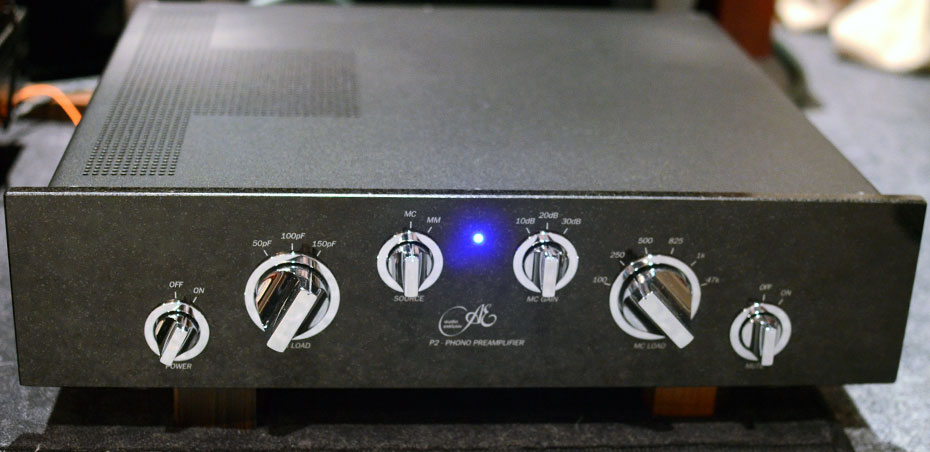Enough already, tell me how it sounds!
The first cartridge, and tonearm combination I tried with the Audio Exklusiv phono stage was the Clearaudio Goldfinger V2 cartridge and an Artemis Labs TA-1 12” Ebony Tonearm (currently under review), and a TW Raven AC turntable. When I spun Ruggiero Ricci’s album with the London Symphony Orchestra, (the very same LP which I used to review the Rossner and Sohn Canorfer-S) the first thing I noticed was the P2 had a much more dynamic, upfront and weightier presentation compared with the Canofer-S or the Ensemble Fonobrio which I was previously using with this cartridge. The sonic image resembled a TV with the contrast and brightness setting at level higher than normal. Ricci’s violin became more prominent against an orchestral backdrop which was more upbeat and snappy. As I went back and forth between various classical recordings, I felt the Goldfinger V2 cartridge, which worked remarkably well with the Rossner & Sohn Canofer-S in my previous review, might not have been the best cartridge for the P2 in my system. The Goldfinger V2 complimented the strength of the P2 rather than its weakness.
Sonic perfection, however, was reached when I switched over to the Lyra Olympos cartridge. The P2 maintained the same sonic characteristics with the Olympos, with the same tightness on the bass which blended in nicely with a top end which was clean and sharply focused, yet the sound became less forceful and less intense. If I have to think of two words to describe the P2, it would be “liveliness” and “immediacy.” Regardless of what I put on, there was a strong rhythmic drive to the sound which made me want to tap my toes.
Listening to the introductory track “Chan Chan” in the Buena Vista Social Club album by Ry Cooder, the music brought the 1940s Cuban social club back to life right in my living room. There was an immediacy and forwardness to the presentation which made the P2 particularly lively with this type of music. Every plucking of the guitar strings carried with it a rhythmic texture which could not only be heard, but felt across the room together with every drum beat. The liveliness of the presentation prompted me to pull out the Toto IV alum which I have not heard for a very long time. Although not very well recorded, the P2 delivered a solid authoritative presentation on the song “Africa.” With every drum beat, the P2 registered a deep punch which was decidedly strong and solid, again with a strong emphasis to rhythm, pace and forwardness to the presentation which makes its liveliness a very much desirable trait to have for this type of music.
Moving onto a piece of music not for the faint of heart, I pulled out Shostakovich’s Symphony No. 8 album with the London Symphony Orchestra, directed by Andre Previn on EMI (ASD 2917). Make no mistake about it, the Allegro non troppo (3rd movement ) is not a piece to play for an after dinner romantic stroll. Shostakovich described it as a poem of suffering, and an attempt to reflect the terrible tragedy of war. The intensity of the performance has been described by some as a graphic depiction of a battle attack with a tempo which marches on a machine. A friend who is not a fan of classical music has called this performance the classical equivalent to Metallica’s “Ride the Lighting.” If you do not have this record, and I do mean the Shostakovich and not the Metallica, please do yourself a favor and buy one from eBay if you can (because it has been long out of print), but be forewarned, I know someone who destroyed four sets of woofers when his amps went into clipping while playing this recording.
From the beginning perpetual rhythmic motion which passes from strings to low brass, to the gradual building up of intensity leading to the gut wrenching grand finale, the performance will squeeze every ounce of dynamics out of your system, demanding full attention from the listener. With the Canofer-S and the Ensemble Fonobrio sitting right beside the P2, I found it hard to resist not making a direct comparison. The P2 certainly did not disappoint, and delivered the performance with deep bass and dynamic impact, more prominent than both Canofer-S and Ensemble. While the Canofer-S delivered more subtle details and top end extension, the Ensemble had an overall softness to the sound which sounded relatively more relaxed and polite. The P2 delivered a performance with huge dynamics combined with unmitigated accuracy, bringing out the good as well as the bad embedded in the record grooves. The bass notes seem to go deeper and deeper with the P2, sending low frequency waves across my listening room when the bows were glided across the lower strings. The sudden burst of anger through the woodwinds and brass were aggressive, prominent but never ear-piercing. They were in fact somewhat rounded. The percussive loud burst had a distinctive dynamic contract which was downright terrifying, accurately portraying the dark, grim and sorrowful emotions which Shostakovich intends to convey. Shostakovich’s Symphony No. 8 may not be best handled by a phono stage with a polite and relaxed character such as the Sutherland PhD, or one which emphasizes euphonic sweetness such as the Kondo M7. It requires something which can create a dynamic contrast with speed and accuracy; something which sounds big. In other words, the P2 will get the job done right!
Moving onto something a little less intense, in the second movement of Benjamin Britten’s Simple Symphony for Strings and Orchestra, the “Playful Pizzicato” is one of only hand handful of compositions for this review that are played in its entirety (Britten Conducts English Music for Strings, DECCA SXL 6045). With approximately 30 performers plucking the strings on their instrument at the same time, the performance provides very little room for error when it comes to tonal accuracy. If you have too much bass, the double basses will become one woolly and muddy sounding boom box, if you have too little they will sound like a cello instead. The P2 had the ability to reproduce clean, tight and deep bass coming from multiple double basses and cellos which were individually distinguishable across the sound stage. The sonics coming from the cellos and violins were clean and snappy, with a holographic image slightly larger than normal, but the spatial and temporal relationship came together vividly. The entire presentation puts you closer to the front row seats than at the back; you feel as if you are intimate with the action in front of you, a trait which I find consistent with all the recordings I played with the P2.
Moving onto pop music, when I played Chris Isaak’s “Wicked Game” (Heart Shape World, Reprise Records 9 25837-1), his deep brooding voice was captured beautifully by the P2, projecting a seductive vocal image which was up close, intimate, and almost heart breaking. The acoustic guitar in the background was rich and syrupy, but didn’t sound tubby or nasal-ish. His close-miked voice was firmly anchored in place. The overall sound was resonant, warm and upfront.
Any complaints?
From a functional perspective, I find it rather amusing that some manufacturer would use tiny dip switches for loading adjustments which are often placed in inaccessible locations such as the back panel, or even inside the chassis. The P2 was able to fulfil this desirable feature by providing On-the-fly adjustable choices on the front panel, but 3 out of the 5 available choices are not really useful. Of all the 30 or so MC phono cartridges I have used in the past, I cannot recall a single one which requires a loading of 500, 1000, or 47k ohm. Although custom choices are available through the back panel RCA inputs, I would have much preferred to see a loading choice of say, 50, 80, 100, 150, 200 or 250ohm on the front panel, which is a more commonly useful range.
The versatility offered by the P2 in terms of gain selection is itself a blessing as well as a curse. Having a phono stage which can accommodate various cartridges’ output is a very desirable feature to have, but the very fact the signal had to go through multiple gain stages will have an effect to the sound, my experience tells me the less is better. Don’t get me wrong here, this does not make the P2 an “inferior” phono stage in any sense; you simply cannot have it both ways. You either go for the gain and or you lose a bit of detail, it is a trade off most of the time. While not the last word on extracting details, the P2 is by no means coarse-sounding or robbed of resolution. It performs every bit as well as any phono stage on the market with more than one gain stage and with negative feedback. It’s sonic characteristic somewhat reminded me of the Audia Flight phono.
Conclusion
For the purist who is focused on a specific set of stringent requirements such as having a remote control, a tube gain stage, a single gain stage, zero feedback or exotic capacitors blessed by Spanish virgins, the Audio Exklusiv P2 will not be for you. For everyone else, the P2 may fit the bill. It is a well-rounded phono stage both functionally and sonically. It is overtly quiet, very dynamic, warm, and slightly rounded at the top and the bottom. The strong points are its accurate and rhythmic presentation which is lively, upfront and immediate.
Once again, my intent for this review is not to be a judge for value, nor to determine whether this is a “good” or a “bad” product by my standards. My goal was to present to the reader the sonic characteristics of the Audio Exclusive so that you can determine whether it would match the sonic qualities you desire. At $7,500 the P2 is no chump change, but for a high quality product from Germany which can handle the best cartridges on the market, I would not hesitate to put one of these in my own living room, the only problem is I already have 8 phono stages in the house. You can only push your limits so far with your wife.
- ← Previous page
- (Page 3 of 3)





